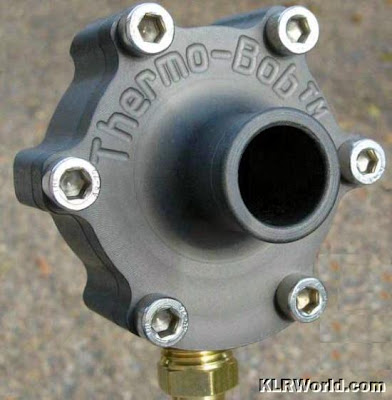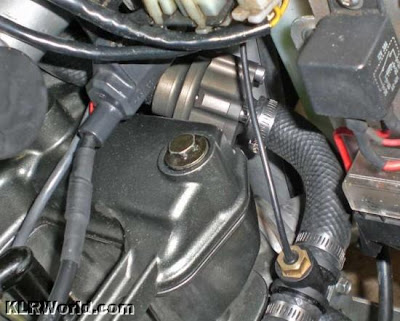
You know how it goes. I am a car and bike tech geek, but sometimes, it takes me a long time to figure out how something really works. In this case, it the cooling system.
I remember back when I "upgraded" Gidget's engine. Since I was living in warm California and had increased the horsepower by about 75%, I figured I better put in a better radiator and fan to keep Gidget cool. Well, it turns out that Gidget has one of those thermostats with a bleed hole in it to keep a little coolant circulating all the time. In the summer, there isn't any kind of coolant bypass since you shut off the heater. I always wondered why it took so long to get the coolant temp up and why you had to run a little choke all of the time, unless you were running her hard. Now I know that the little bleed hole was letting coolant into that nice big radiator and circulating cold water back into the engine, even when the thermostat was closed.
I got a better understanding of this when I replaced my KLR gauge pack with an Acewell instrument computer. The temp gauge on the Acewell couldn't use the Kawi head temp sensor, so I had to put an Acewell temp sensor into the top radiator hose. Imagine my surprise when the temp gauge read 135 deg F on a warm summer day. The coolant temp also varied a lot, bouncing around even when just riding down the highway.
It turns out that the KLR has a pretty big radiator because it has to cool the engine under high temp, low speed off-road conditions. In the stock system and under highway or cold weather conditions, the thermostat stays closed until the coolant at the top of the cylinder gets hot enough, then it opens allowing very cold coolant into the bottom of the cylinder until the thermostat closes again. That means that the cylinder is cooler than thermostat control temperature on average and that the temp is oscillating between cold and warm.

The temp history shown here is for stock system on on a cold day by the inventor of the Thermo-Bob. The Thermo-Bob is an external thermostat with a coolant bypass that circulates coolant without going through the radiator when the thermostat is closed. The blue line, inlet temperature, shows how cold the coolant coming into the cylinder can be and how the thermostat oscillates in its control.

This schematic shows how the stock system works, followed by a similar schematic of the system with the Thermo-Bob. By creating a coolant bypass of the radiator and thermostat, warm coolant circulates continuously. When the thermostat opens, a controlled amount of cooler coolant mixes with the bypass coolant, making for a warmer, more consistent coolant temperature. If you think about it, this is the same approach as modern cars use where the heater flow acts as a bypass. Maybe I should have soldered up the bypass hole in Gidget's thermostat and left the heater valve open.

This graph shows the inlet and outlet temperature traces under similar conditions with the Thermo-Bob installed. Notice how much smoother and better controlled the temp traces are. The hope is that fuel economy will be a little better and oil temperature will be a little higher and more consistent. At the very least, my temp gauge will register correctly.

Naturally, I ordered my self a Thermo-Bob. This picture shows the Thermo-Bob installed on a KLR from a web site picture. This guy has a Trail Tech instrument computer, so he had to install his temp sensor in the radiator hose along the side of the engine. I had to do the same thing, except my Acewell sensor adapter was far too long for this location. I cranked up the machine shop and made myself a version that saved about 1" on length.

Although this aluminum is nice and shiny when new, I realize that raw aluminum will eventually tarnish, so I'm trying something that works pretty well no raw metal of machine tools. Instead of anodizing or painting it, I "polished" the aluminum with car wax. I leaves a shiny and durable coating that I hope will keep oxidation at bay. We'll see.
The Thermo-Bob works as advertised. The temp gauge reads a nice steady temp in a range of temperatures and subjectively, the bike warms up a little quicker. I'm looking forward to a trip to see if I can tell any improvement in gas mileage.
No comments:
Post a Comment